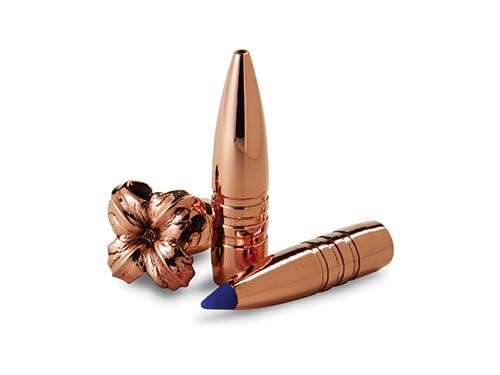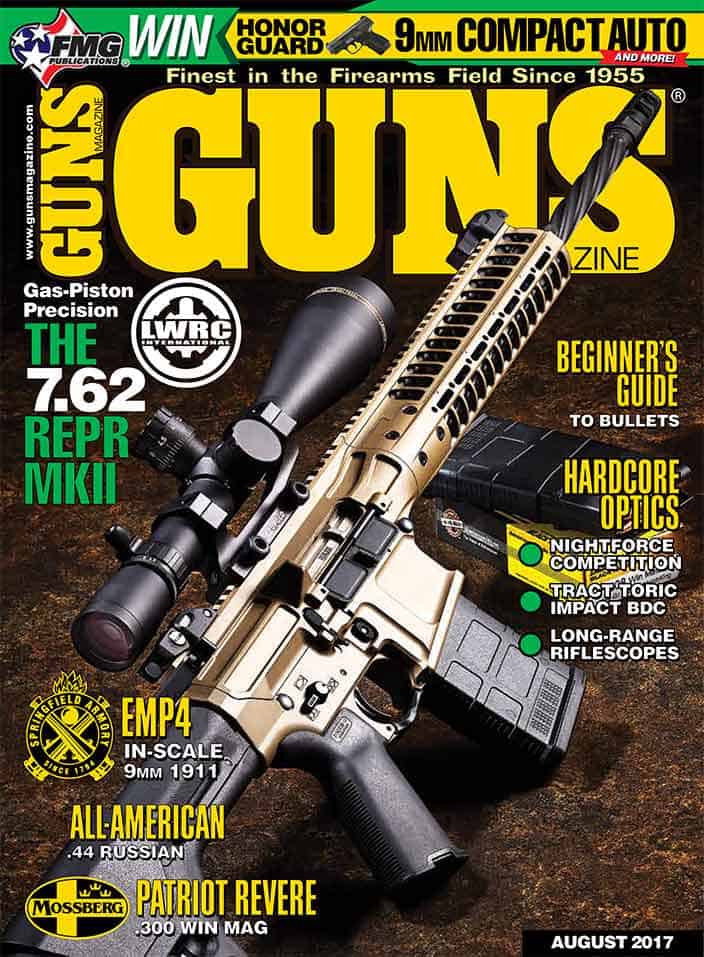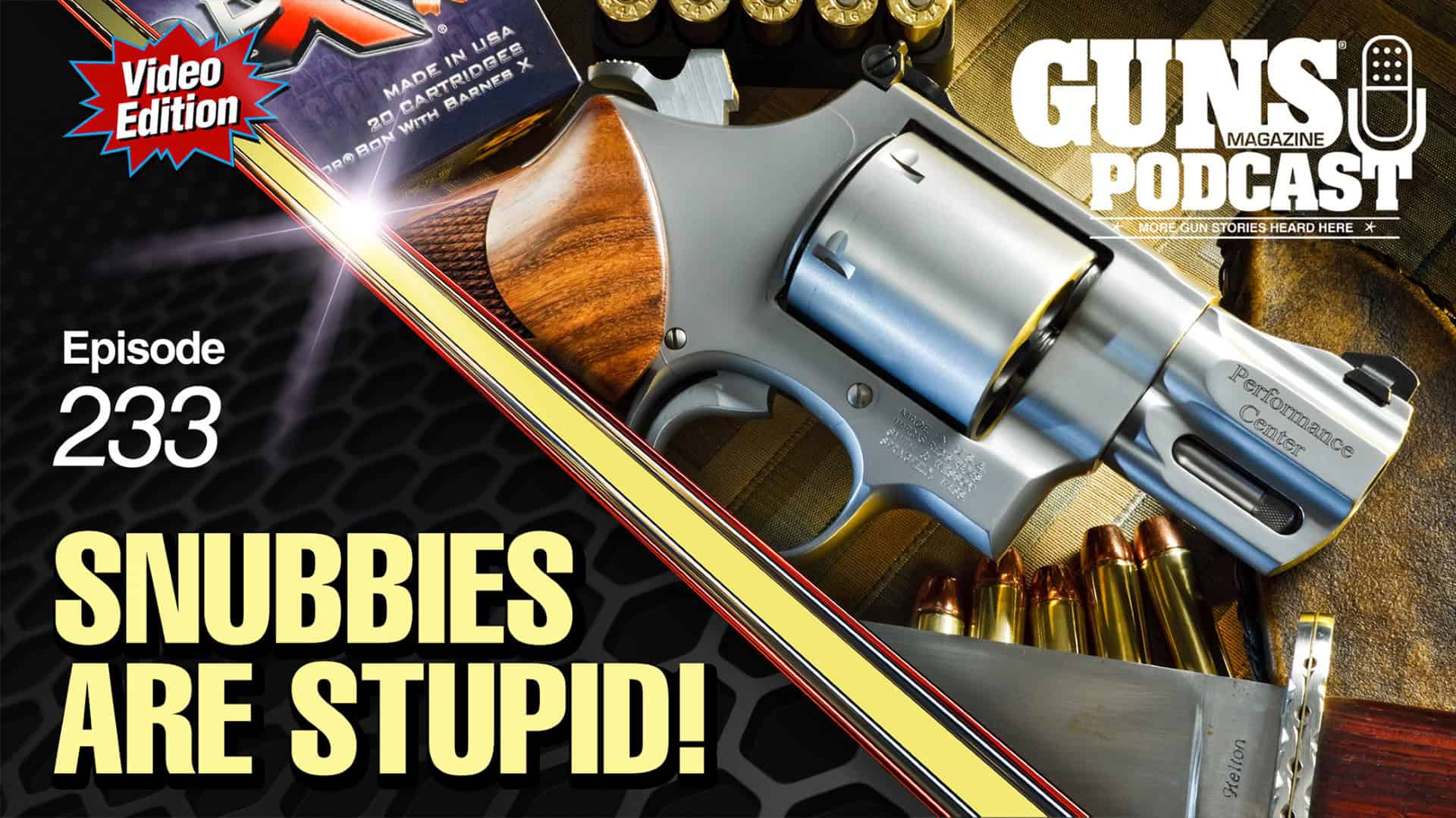The Missile Type
Bullets Come In Many Types, Featuring
Vastly Different Constructions To
Fit Almost Any Application
Here begins a series of articles I wish someone had written when I was a novice shooter and handloader. My goal is to keep these discussions at an introductory level. Mostly, in this entry, I will describe and define the various types of firearm projectiles we shooters routinely read about, see and use.
Historically, in firearms terminology, ball meant any projectile, regardless of shape. Sometimes, we still use this terminology, as in military ball ammo (usually to describe a full-metal-jacket spitzer).
The simplest bullet we encounter is the spherical (round) ball. The common example of this is the BB, as used in our beloved BB guns. Here, BB specifies a projectile size. A BB-gun’s BB is 0.177-inch in diameter.

A selection of .22-caliber rifle bullets include (left to right) three jacketed tipped spitzers and five jacketed
hollowpoints. The design of each gives violent expansion on varmints. Differences in weight, jacket thickness,
core material and point design (size of hollowpoint, jacket thickness and existence of a plastic tip, or not) all
influence ballistic efficiency and terminal performance.
Birdshot
We also use spherical projectiles in shotgun shells. These are made of lead, lead alloy, mild steel, or some other material such as bismuth. In this application, we refer to these as shot, buckshot, or roundballs, depending upon size and, to some extent, intended application.
The smallest lead or lead alloy shot normally used is No. 12, measuring 0.050-inch in diameter. The largest is BB, and in shotgun shells it is not 0.177-inch, but 0.180-inch in diameter. I offer this confusing bit of information now because such perplexing mismatches are common in firearms terminology, so get used to it! It’s all part of our hobby. For example, where numbers are used, No. 12 through No. 2, the smaller the number, the larger the shot, but in shotgun bore sizes the opposite is true, and a smaller-numbered shotgun gauge indicates a larger-diameter bore.
Shotgun gauge naming reflects how many spheres of pure lead of a given size it takes to weigh 1 pound. So, the bore size of a 12-gauge takes 12 lead spheres of a certain diameter (in this case 0.729-inch balls weighing 583 grains) to achieve 1 pound. Similarly, for all other shotguns with “gauge” at the end. The exception is the .410, which designates a caliber rather than a bore size measured in lead spheres. The .410 would actually be nearer 68 gauge. The “.410” reflects bore size, in thousandths of an inch much as our rifle calibers are, and we correctly refer to it as the four-ten-bore shotgun. Confusing? I hope you’re getting used to it!
In steel shot, sizes now run from No. 6, 0.11-inch, to F, 0.22-inch. Here, each shot size uses the same name as the corresponding lead shot, but includes Airgun, at 0.177-inch, and BB, at 0.180-inch.

The .35 is truly one of the few crossover rounds, because it can use blunt 0.358-inch bullets meant for
the .357 Magnum, up to dedicated spitzer-style rifle bullets. Selection of .35-caliber rifle bullets include
(left to right) a cast, truncated cone, two jacketed truncated spitzers, cast semi-wadcutter, cast long
flatnose (intermediate between a truncated spitzer and a truncated conical). The manufacturers do not
intend these cast bullets to expand significantly—if at all—these designs rely upon a large meplat to
rapidly transfer energy to the target.

These Alaska Bullet Works 450-grain, .50-caliber Bonded-Core expanded bullets (top) show classic
mushroom deformation, with outstanding expansion, symmetry, and weight retention. Bonding mechanically ties
the lead core to the jacket, preventing separation and allowing each to support the other. Such bullets retain more
weight and expand more dependably than unbonded conventional bullets. Expansion through malleable
deformation consumes energy. In a low-velocity load, this is insignificant; conversely, in a high-velocity load, such
deformation consumes significant energy.
Buckshot
Modern buckshot sizes run from No. 4, at 0.24-inch, through 000, at 0.36-inch, regardless of material used. We normally refer to a shot bigger than 0.36-inch diameter as roundballs, and we mostly use these in muzzleloading guns.
Shotshells are also loaded with slugs. These come in many types. A complete discussion of those would require its own long article. What is important here is slug loads have one, heavy projectile that might or might not be designed to expand on impact. Other projectiles, such as miniature darts (flechettes) are also available in shotshell loads.
Although bullets are manufactured in widely different designs and materials, they are all used almost exclusively in rifled bores. Considering basic shapes of bullets mostly used in handguns first, these bullets are usually blunt. The most blunt is the wadcutter with essentially a flat nose. A semi-wadcutter has a conical nose with a large flat end (meplat, pronounced meh-pla) and a step between base of the cone and bullet shank. A conical (or conical nose) has a large meplat and no step between cone and bullet shank. A roundnose has a more-or-less spherical front end. A roundnose flatpoint has a spherical nose with significant meplat at the top. Bullets of these designs are compact and often quite accurate, and are generally best suited for target shooting and short-range hunting. Most cast and swaged bullets are of these designs. Blunt bullets also include roundballs, seldom used outside shotgun shells or muzzleloaders.
The second class of bullets are the pointy ones. Pointed bullets are mostly found in rifle ammunition and bullets of this shape traditionally have a soft, lead core covered in a thin, harder jacket material normally blended from copper and tin. These include the full metal jacket spitzer, a bullet featuring a sharp nose with the jacket material covering the nose and open at base. The spitzer has a sharp nose with an exposed lead core at the front end of the jacket. The tipped spitzer has a sharp nose with plastic or other material making up the tip (to prevent damage in handling, recoil, and firing). The spitzer boattail is similar to all the above nose designs, but with a tapered base. Compared to blunt bullets, pointed bullets retain velocity better while passing through the air, and therefore are more useful for long-range applications.
The term indicating the tapered portion of a pointed bullet nose is ogive (pronounced oh-jive). Esoteric differences in ogive shape exist. Manufacturers have given these shapes many names, some of which are useful and some of which are misleading. What a novice needs to understand is a bullet with a longer ogive will usually retain velocity better than a bullet with a shorter ogive.
It is hard to apply an accuracy standard to shape, but in certain applications, some shapes work better than do others. For example, the conventional roundnose is the most accurate bullet ever tested in target loads in the .22 rimfire, the .38 Special, and similar revolver and pistol cartridges. Conversely, to limit wind deflection, high-power target rifle shooters always use pointed bullets. In this situation, they are giving up a small amount of intrinsic accuracy to significantly reduce wind deflection—sideways bullet movement in response to a crosswind. (All too often, gun writers and editors erroneously refer to this as drift, which is lateral bullet movement resulting from entirely different phenomena). Reducing wind deflection reduces the inevitable windage error resulting from a shooter’s inability to perfectly correct for a changing crosswind and, more importantly, it reduces the error resulting from a change in wind as the bullet travels from gun muzzle to target.
Overall, excepting bullets used in guns and shooting situations where most of the trajectory occurs while the bullet is traveling subsonically, pointed bullets have an overall edge for most applications. Exceptions are important.
When the bullet base tapers conically, rather than ending after a small radius, we call it a boattail bullet. Its base diameter is still a significant portion of bullet diameter. Such bullets are easier to load into cases and have about 5-percent less aerodynamic drag.
We use boattail bullets in hunting and target loads. Some folks argue boattail bullets are intrinsically less accurate than flatbase bullets. Records from target shooters offer little support to this claim.
Historically, lead was the most desirable material for making bullets. It is easy to swage or to melt and then cast into desirable shapes. It is dense and compact. Because of the high density, relatively short lead or lead-alloy bullets offer excellent ballistic efficiency. Such bullets give good accuracy and terminal performance in low-velocity loads.

Unlike conventional bullets, modern Barnes X bullets are made entirely from pure copper. Expanded (left),
shows how the individual petals fold back, with minimal material loss and more bending than gross
deformation. An unfired conventional X (middle) has a hollowpoint and, the Tipped X (right) has the
addition of the plastic tip, which improves ballistic coefficient and increases expansion at low retained velocity.

The selection of bullet shapes in .35 Remington factory loads show the variety of shapes you will encounter
in rifle ammo. Bullet proper names include (from left to right) a truncated spitzer flatnose, truncated spitzer
roundnose, truncated spitzer flatnose (with a small flat nose), and roundnose. Excepting the third from the
left, which is a pointed design, each of these falls within the blunt-bullet category. As you might well surmise,
shape naming is highly subjective! For example, consider both roundnose designs. Exactly when does any
particular design qualify as a “truncated spitzer,” rather than a “true roundnose” bullet?
Cast Bullets
High performance lead alloys used in bullets usually include a small amount of antimony, tin, and sometimes arsenic. Antimony increases hardness, tin eases casting and arsenic causes rapidly quenched cast bullets to become dramatically harder. Rapid quenching of just-cast or reheated bullets hardens these sufficiently for use at 1,500 fps in handguns and 2,000 fps in rifles. These alloys also hold together well after impact in hunting situations.
A softer alloy of 20 parts lead and 1 part tin (20:1), with minimal other additives, is the ideal material for bullets used in black powder loads. In black powder cartridge loads, such bullets are capable of amazing accuracy.
Various manufacturers now use nearly pure copper in many hunting bullets. These include a hollowpoint with endwise-internal cuts allowing the petals to fold open in response to hydraulic loading as the bullet enters a game animal. As such, these bullets use up less of the delivered energy while expanding (folding takes far less energy than the malleable deformation of a conventional bullet does). These also retain more of the delivered weight. For example, the 6mm, 90-grain Barnes X often penetrates deeper than the 7mm, 175-grain Nosler Partition. And, when recovered from game, the main portion of this tiny X bullet often weighs more than the main portion of the Partition bullet.
Various dangerous-game bullet manufacturers now use copper alloys (typically brass) in their most effective non-expanding bullets. These usually have a small roundnose or conical section with a large flat tip. The meplat is usually about 2/3 of bullet diameter. This design is well proven to offer vastly superior penetration (deeper and in a straighter line), when compared to the obsolete roundnose solids our ancestors used. With heavy, dangerous game, straight-line penetration is everything.
Manufacturers have occasionally made bullets from mild steel. While it might seem use of such bullets would lead to significant bore wear, this is not actually much of a concern. The steel used in the barrel is many times harder than the steel used in the bullet jacket, bore fouling acts as a barrier that protects the bore, and these bullets are usually thinly plated with a less abrasive material. Such bullets are inexpensive but equally limited in accuracy, terminal performance and ballistic efficiency.
Bullets having a separate core and jacket, or a bonded core, usually have a gilding metal alloy jacket (95 percent copper and 5 percent zinc) and a lead-alloy core. Other jacket materials include mild steel, aluminum, copper, zinc and plastic. Expect to see plastic gaining in popularity for handgun bullets. Otherwise, gilding metal is apt to hold reign long as the leading jacket material for hunting and target bullets.

After watching this distant bull feed for more than an hour, while waiting for his brother to reach him, Mic’s son,
Jody, fired two perfect shots as Joey spotted. This was the second of more than 20 good bulls the McPhersons
have taken from this area over the past 15 years or so. Food on the table is the result of solid work at the
handloading and shooting bench.

The late By Smalley and McPherson designed this .45-70 bullet made as a small custom order. It was recovered
from soft dirt at 1,538 yards. It has a typical boattail, is made of leaded brass, and is the longest bullet that will
assuredly stabilize when fired from a .45-70 with standard rifling twist rate. The ogive and boattail design
optimizes balance to assure stability as it travels despite starting out above the speed of sound, then, after
traveling several hundred yards, slowing to below the speed of sound for the last many hundred yards of flight
to the target. Unlike many pointed bullets launched at supersonic speeds, it remains accurate, regardless of
distance fired, because it resists the aerodynamic buffeting during the transition from supersonic to subsonic
flight. Expensive to produce, this specialized design has no application outside extreme long-range target
shooting. The bullet is no longer available.
Conventional cores in jacketed bullets are made and used for different purposes. Tin occurs in varmint bullets. Soft lead in target, and harder lead-alloys for target and hunting. Mild steel is found in military bullets and tungsten carbide in hunting. Each of these has unique values.
Manufacturers have recently begun making varmint bullets with composite cores. Usually, these are made of copper particles pressed into an almost solid chunk, perhaps with a bonding agent that plastically deforms during firing but catastrophically fails upon impact. Excepting ballistic efficiency, such bullets are superior in all ways to conventional varminting bullets. These will disintegrate upon impact and will do so at velocities far below what will routinely expand a conventional varminting bullet.
The advent of the plastic tip is among the most significant improvements in rifle bullets for big game hunting, varmint hunting and target shooting. As noted above, such a tip protects the bullet against damage in handling, recoil battering and tip melting in flight (for the fastest of loads, when using an appropriate material for the tip). It also takes up room without adding much weight, so manufacturers can offer lighter varminting bullets with sharp points and, therefore, relatively high ballistic efficiency. Such bullets shoot flatter, have less wind deflection, and carry more energy downrange. And, manufacturers can design such bullets to expand at relatively low impact velocity, while still holding together when launched by the hottest rounds and from guns with unusually fast rifling twist rates.
While this is by no means an exhaustive study of modern bullets, it does cover the basics in sufficient detail and you should be able to understand your options. In a subsequent piece, I will discuss how bullet choice influences load pressure, accuracy, barrel life and effectiveness.





